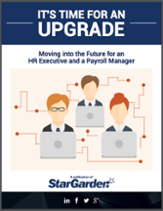3 Ways Enterprise IT Solutions Support Your “Triple Bottom Line”

In today’s business world, it’s not enough to just worry about your company’s profitability. Consumers, competitors, and legislative initiatives reward companies and brands that embrace corporate social responsibility strategies and environmental initiatives. This focus on a more holistic principle of sustainability and community interdependence is known as “triple bottom line” thinking because it considers three aspects in calculating business success: social, environmental, and financial.
Modern technology contributes significantly to a company’s triple bottom line. Businesses can operate greener with “paperless” offices, reduce their carbon footprint by drastically reducing travel using online resources, and automate systems to “reduce, reuse and recycle” everywhere possible in their organization. Technological advances also improve employee engagement, quality of life, and productivity by making it possible for employees to telecommute from anywhere if they have an Internet connection. These more efficient, environmentally responsible systems and better, more flexible company culture also tend to improve a company’s financial bottom line, reducing employee turnover and building goodwill.
With Progress Comes Problems
Moving at the speed of technology can have unintended consequences for your business, however. Adopting a new program, application, or smart device every other quarter just to keep up with the trends can be detrimental to business processes, productivity, and quality of life for your employees.
Today’s human resources information systems (HRIS) are one example. In today's world, a company has more than just one online HR core system. Many employees are expected to access standalone learning management, talent management, and performance management systems, and more, on a daily basis – and to use each with proficiency to complete their day-to-day tasks. Each time your business upgrades a system or adds another, your employees’ workload increases as they integrate more training into their existing job duties. Not only do these upgrades cost your business money, but overwhelming your employees with constant change reduces their satisfaction and leads to burnout. Plus, having to switch from system to system increases digital clutter, affects workers’ attention spans and productivity, and can lead to costly mistakes.
There are unexpected negative aspects to the death of the 9-to-5 work week, too. As modern work systems and technology evolve to allow employees to work anywhere, anytime, the line has blurred between where an employee’s work ends and personal life begins. Adopting every new technology to allow your employees to be reachable 24 hours a day, seven days a week can foster a culture of constant, endless work, as employees feel unable to disconnect from the office even when they do go on vacation.
A Flexible, Integrated Enterprise IT System is the Solution
The market is flooded with IT and enterprise solutions, most of which are incompatible with another. This causes gaps in data flow and connectivity, duplication of data (and effort), and a constant battle to keep information updated. Truly effective enterprise HR solutions are able to “talk” to and easily integrate with existing applications and allow a smooth flow of information. A fully functional integrated system easily provides organizational insights, views of progress, and strategic projections, without overloading employees with an abundance of applications. An integrated enterprise system with automated HCM workflows can even allow employees to take real vacations again by allowing easy transfer of access and delegation of responsibilities among employees.
Not only can an integrated enterprise IT solution help alleviate the problems that arise from technology, it can also proactively help support your triple bottom line.
- People – Having better, more intuitive systems can help the people working on them reduce stress and be more productive. This allows them to be able to reach deadlines, achieve goals, and have a better work-life balance – all of which improves employee engagement and company culture, attracting new talent and retaining existing assets.
- Planet – Integrated platforms allow users to do more in a “one stop solution,” versus standalone pieces that need to integrate with existing systems and processes. Rather than constantly buying and discarding software, devices, and systems that do “just one thing,” integrated systems allow organizations to reduce the proliferation of wasted resources and energy.
- Profits – With a more productive and motivated work force, more value-added work that directly impacts revenues gets done, which in turn helps organizations to reach their profit goals. Plus, reducing overhead, turnover, and training costs helps companies operate more efficiently… all of which improve your business’s traditional “bottom line.”
StarGarden’s integrated IT solutions can help your business improve its triple bottom line. Contact us today to find out how you can try our most powerful and user-friendly integrated HR system ever, StarGarden 5.0, absolutely free.

